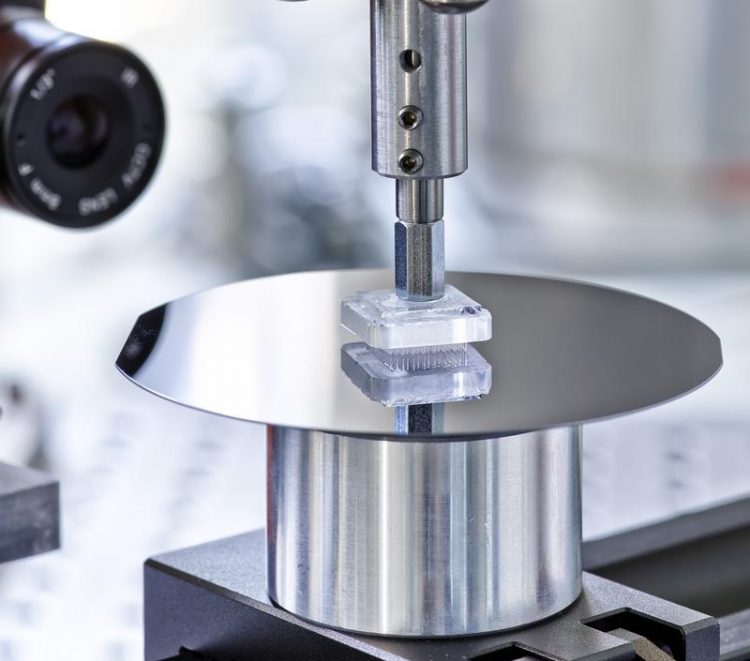Switchable adhesion principle enables damage-free handling of sensitive devices even in vacuum

Gecomer© technology at the INM Source: Uwe Bellhäuser, only free within this press release
During the production process, these parts are transferred in between many process steps. Each pick-up and release with conventional gripping systems involves the risk of either contamination of the surfaces with residues from transportation adhesives, or damaging due to mechanical gripping.
Suction cup systems diminish residues, but fail in a vacuum or on rough surfaces. Researchers at the Leibniz Institute for New Materials (INM) enhanced the Gecko adhesion principle that adhesion can be switched on and off in vacuum.
With the “gecobot 2.0”, the researchers from the INM will be presenting their new Gecomer® technology at the International Innovation Conference and Expo TechConnect World from June 16 to 17, Washington DC, USA, at Stand 301in the German Area.
“Artificially produced microscopic pillars, so-called gecko structures, adhere to various items. By bending these pillars, the adhesion can be switched off. Thus, items can be lifted and quickly released,” explains Karsten Moh from the Program Division Functional Microstructures.
“This technique is particularly interesting in vacuum, as suction cups fail here,” says Moh. Parts, for example, can be moved within a reactor chamber for vapor phase deposition (CVD or PVD). With the currently developed adhesion system, objects with smooth surfaces can be lifted and released, having a weight of approximately 100 grams per square centimeter (ca.0.03 lbs per square inch).”
In our test runs, the system has proved successful even after 20,000 runs”, says the upscaling expert Moh.
The development group is now working on the gripping of more complicated objects without leaving residues using this adhesion principle. “Then, we could also move glass lenses or automobile bumpers without damaging them in the production process,” says Moh.
From June 16 to 17, the researchers of the INM present this and further results at Stand 301 in the German Area. This includes new developments in the field of display techniques, printed electronics, corrosion protection, antifouling and antifriction.
Your expert at the Stand:
Joachim Blau
Dr. Karsten Moh
Your expert at the INM:
Prof. Eduard Arzt
INM – Leibniz Institute for New Materials
Head Functional Microstructures
Phone: +49681-9300-500
eduard.arzt@inm-gmbh.de
INM conducts research and development to create new materials – for today, tomorrow and beyond. Chemists, physicists, biologists, materials scientists and engineers team up to focus on these essential questions: Which material properties are new, how can they be investigated and how can they be tailored for industrial applications in the future? Four research thrusts determine the current developments at INM: New materials for energy application, new concepts for medical surfaces, new surface materials for tribological applications and nano safety and nano bio. Research at INM is performed in three fields: Nanocomposite Technology, Interface Materials, and Bio Interfaces.
INM – Leibniz Institute for New Materials, situated in Saarbruecken, is an internationally leading centre for materials research. It is an institute of the Leibniz Association and has about 195 employees.
Media Contact
All latest news from the category: Information Technology
Here you can find a summary of innovations in the fields of information and data processing and up-to-date developments on IT equipment and hardware.
This area covers topics such as IT services, IT architectures, IT management and telecommunications.
Newest articles

Bringing bio-inspired robots to life
Nebraska researcher Eric Markvicka gets NSF CAREER Award to pursue manufacture of novel materials for soft robotics and stretchable electronics. Engineers are increasingly eager to develop robots that mimic the…

Bella moths use poison to attract mates
Scientists are closer to finding out how. Pyrrolizidine alkaloids are as bitter and toxic as they are hard to pronounce. They’re produced by several different types of plants and are…

AI tool creates ‘synthetic’ images of cells
…for enhanced microscopy analysis. Observing individual cells through microscopes can reveal a range of important cell biological phenomena that frequently play a role in human diseases, but the process of…





















